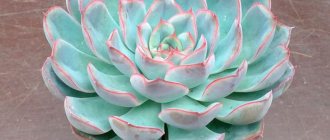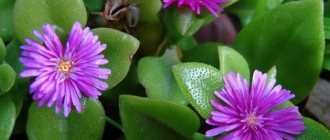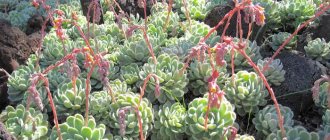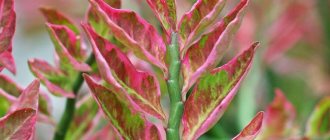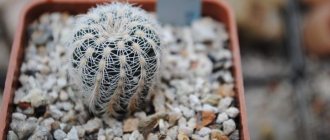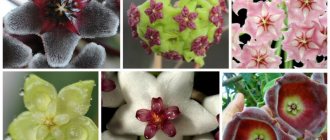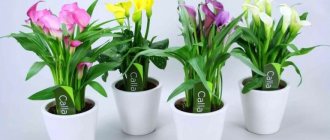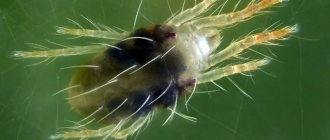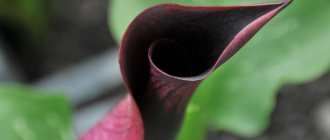Echeveria agave. Photo Echeveria or stone rose , as it is also called because of its external resemblance to the flower, is an exotic succulent plant that does not require much attention . A warm, well-lit place is the basic requirements of the plant. In return, it will add a hot desert “zest” to any interior.
It is a perennial succulent plant from the Crassulaceae family, with about 150 species. Echeveria is native to Central and South America.
The rosette, with a diameter of 10 to 40 cm, is shaped like a rose. It grows slowly: it produces several new leaves and daughter rosettes per year. The root system is superficial. Fleshy, dense leaves reach 3-20 cm in length, 1-15 cm in width, and have an oval shape with a sharp end. The leaf blade may be glossy or slightly pubescent. Depending on the species, the foliage color is green, bluish-gray, reddish or violet-pink.
| It grows slowly: it produces several new leaves and daughter rosettes per year. |
| It blooms mainly in spring or summer, some varieties in winter, for 2-3 weeks. Bell-like flowers are collected in inflorescences on a long peduncle. |
| The plant is easy to grow. |
| Perennial. |
Features of growing at home. Briefly
| Temperature | In summer – 20-27 degrees, in winter – 10-15 degrees. |
| Air humidity | Low, does not require spraying. |
| Lighting | Echeveria at home needs bright lighting; a south or south-east window sill is suitable. |
| Watering | Moderate in summer - once a week, scanty in winter - once a month. |
| Priming | Light sand mixture, well permeable to air and moisture; substrate for succulents. |
| Feeding and fertilizer | During the growing season, apply fertilizer for cacti once a month. |
| Transfer | Young specimens once a year in the spring, adults - once every 3-4 years. |
| Reproduction | Daughter rosettes, leaf cuttings, seeds. |
| Features of cultivation | The leaves are very fragile; in summer it is useful to take the plant out into the fresh air. |
How to create a composition with echeverias
Echeveria in compositions most often acts as a central element. In the southern regions, the plant fits perfectly into the garden landscape. In both cases, in addition to the idea, you need knowledge of landing techniques. Simple techniques will help you not only create an original and effective miniature, but also maintain its shape for a long time.
- Decide on a container. To plant in open ground, completely clear the intended area.
- Lay out one after another in successive layers: drainage expanded clay, soil diluted with vermiculite or perlite, moss.
- For a vertical, suspended structure, stretch and secure the coarse mesh, completely drowning it in the soil mixture.
- Place the seedlings so that there is enough space between them for subsequent growth.
- Add decorative details: shells, pebbles, figurines, etc.
- If you are creating a mix composition, combine only succulents of the same type with similar requirements for living conditions.
- Water in a targeted manner: water should not fall on the leaves.
The topic is discussed in more detail in the article: Compositions from succulents: do-it-yourself mini-garden
Caring for echeveria at home. Details
Echeveria agave.
Photo Caring for echeveria indoors is simple and not burdensome. The main condition is to take care of the plant due to its fragile leaves with a thin protective shell, which is very easy to damage. Therefore, it is better to minimize any contact with the flower.
Bloom
Most echeveria bloom for 2-4 weeks in spring and summer .
The rosette produces a long (up to 70 cm) lateral or vertical peduncle with small bell-like flowers collected in inflorescences. The color of the petals depends on the level of illumination: in dim light - yellow, in bright light - orange or red. After flowering, babies may form at the end of the peduncle.
Temperature
The plant loves warmth. The optimal temperature for it in summer is 20-27 degrees, in winter – 10-15 degrees, but not lower than 6. For species that bloom in winter, the temperature should be maintained at 18-20 degrees.
The leaves of the plant are very sensitive to cold and frost; under their influence, the rosette significantly worsens its appearance.
Therefore, it is important to protect the stone rose from frosty air when ventilating in winter.
Spraying
Indoor echeveria prefers low air humidity and feels great even next to operating heating devices. Therefore, there is no need for spraying or any other air humidification.
Lighting
Being a native of deserts and semi-deserts, she needs bright lighting; she is not afraid of even direct sunlight. The best place is a window sill facing south or southeast .
The plant can tolerate light shading, but in this case the rosette will stretch in height. In summer, it is recommended to take it out into the fresh air: onto the balcony or into the garden, taking care to protect it from rain and wind.
Watering
Being a succulent, echeveria needs moderate and even scanty watering.
In summer, the soil is moistened approximately once a week after the top layer of soil in the pot has dried out by 3-5 cm. In winter, watering is reduced to once a month. When moistening, it is important to avoid getting water on the leaves and especially inside the rosette - this can lead to rotting. After watering, pour out the remaining water in the pan. The rule applies: it is better not to top up than to overfill.
For irrigation, settled or rainwater at room temperature is used..
Pot
Since echeveria has a shallow root system, it needs a wide but shallow pot. It is optimal that its diameter is 1.5-2 cm larger than the diameter of the plant. It is imperative to have drainage holes, otherwise the roots will begin to rot as a result of stagnant moisture.
Priming
Homemade echeveria needs loose, low-nutrient soil with a neutral reaction based on sand.
Store-bought substrate for succulents is perfect. If you have the opportunity to prepare the mixture yourself, you can choose one of the options:
- 2 parts sand, one part each of leaf and turf soil;
- 2 parts coarse sand, 1 part peat, 1 part loamy soil.
To prevent root rot, you can add a little crushed charcoal to the mixture.
It is necessary to lay a layer of drainage at the bottom, which would occupy 1/3 of the pot. You can use pebbles, expanded clay, broken bricks, and clay shards as it.
Feeding and fertilizer
Echeveria does not need frequent feeding. It is enough to feed it once a month during the growing season (spring and summer) with complex fertilizer for succulents (cacti) in half the dosage.
Excess minerals can damage the plant's delicate root system.
Transfer
It is better to transplant echeveria in the spring, at which time it will more easily withstand stress and resume growth faster.
Young specimens are replanted annually, adults - as needed, every 3-4 years. They are advised to change the top layer of soil every spring.
Replanting is carried out very carefully to minimize damage to the fragile root system and leaves.
Watering before replanting should be reduced in order to replant the flower with a dry clod of soil.
Trimming
The flower does not require shaping or other special pruning. Dried lower leaves are periodically removed to preserve the decorative appearance of the plant.
If after winter the rosette has become too elongated, you can cut off the top, leaving a “stump” 3-4 cm high. This way the echeveria will rejuvenate and new shoots will begin to grow.
Rest period
Most species are dormant in winter. At this time, the plant should be kept in good light and a temperature of 8-15 degrees. Watering is reduced to 1 time per month.
Is it possible to leave without care during the holidays?
Echeveria is a very hardy plant. By placing it on a brightly lit windowsill and moderately moistening the soil, you can safely leave for 2-3 weeks without worrying about the well-being of the flower.
Features of plant flowering
Echeveria - species: agave, Pulidonis, Black Prince, Purpuzorum, Lilacina
Some hybrids require special conditions, otherwise they will not bloom.
Important! Echeverias in mixes (small size) are usually used to create flower ensembles.
Blooming succulent
Period of activity and rest
In the spring and summer months, echeveria blooms for 14-30 days. In winter, most of the representatives of the genus retire. At this time, the regime is seriously changed: the temperature is reduced to 8-15 ℃ and irrigation is reduced to one procedure per month.
Types and shape of flowers
Small buds are located in inflorescences located on a vertical lateral peduncle. The tone of the petals depends on the lighting conditions:
- lack of sun causes yellowness;
- a sufficient amount - a reddish or orange tint.
At the end of the budding period, babies are formed on the peduncles.
Reproduction
Echeveria propagates at home in two main ways: leaves and rosettes.
Echeveria leaf propagation
The lower healthy leaf is carefully torn off and dried in the open air for 2-3 hours. The leaf is then gently pressed into the echeveria soil mixture. The soil is moistened with a spray bottle. The container is covered with polyethylene or glass and placed in a well-lit, warm (25 degrees) place. The “greenhouse” is ventilated daily and moistened as necessary.
After 2-3 weeks, one or more babies should appear at the base of the leaf. Young plants can be transplanted into individual pots when the mother leaf dries out.
Reproduction by rosettes
The basal or apical rosette is cut off with a sharp knife. The lower leaves are carefully removed. The rosette is dried in the open air for 2-3 hours, then planted in slightly moistened soil for echeveria. The plant is kept at a temperature of 22-25 degrees. The young plant should take root within a month.
Diseases and pests
Rarely attacked by pests and diseases, this can sometimes happen due to improper care.
Here are the main problems and the reasons for their occurrence:
- The base of the rosette rots due to excessive watering.
- Yellow spots on the leaves indicate stagnation of water in the soil or a fungal disease.
- Brown spots on echeveria leaves are a fungal disease.
- The leaves have become soft, yellowed and begin to rot - moisture stagnation in the middle of the rosette.
- Stretched out - lack of lighting.
- Lost turgor - insufficient watering.
- Leaves and stems turn black - low temperature, waterlogging of the soil.
Occasionally it is affected by spider mites, aphids, and mealybugs.
Types of Echeveria domestica with photos and names
Echeveria elegans
It has a thick stem, up to 5 cm high. It produces lateral daughter rosettes. The light green leaves with a bluish waxy coating have an oblong shape. They reach 6 cm in length and 1 cm in width. The flowers are orange-red with a yellow tip.
Echeveria carnicolor
The medium-sized oblong leaves have a pink tint.
Echeveria glauca
It has waxy leaves of a gray-blue color with a pink border along the edge. They are shaped like a spoon. The lateral peduncles delight with orange flowers collected in inflorescences.
Echeveria Black Prince
Hybrid variety with red-brown foliage. The diameter of the rosette is up to 15 cm. The flowers are chocolate-red or orange on a high peduncle.
Echeveria leucotricha
Has a short stem. The diameter of the rosette is up to 15 cm. The lanceolate leaves, convex on the back side, are green in color with brown ends. The entire leaf plate is covered with thick white pile. The leaves are 6-10 cm long, 1-3 cm wide. On a peduncle up to 50 cm high, red-brown flowers are collected in inflorescences.
Echeveria fulgens Lera
The species is bushy. The mother rosette produces thick shoots with daughter rosettes at the ends. The leaf blade, up to 10 cm long and up to 4 cm wide, has a green-burgundy color and a waxy shiny coating.
Echeveria Derenbergii
It has dense rosettes, up to 6 cm in diameter. Gray-green spatulate leaves with pink tips are up to 4 cm long and up to 2 cm wide. Short peduncles (5-6 cm) with yellow-orange flowers appear from the upper axils of the leaves.
The most spectacular varieties of echeveria
We offer a selection of photos with the names of the most popular and spectacular varieties with a brief description.
- Echeveria Lau is a favorite of plant designers. A bright yellow flower against a background of blue voluminous leaves will look great surrounded by any other succulent representatives.
- Echeveria Miranda agave. The height of the stem is about 35 cm. The variety is known for a large number of cultivars with extravagant colors: from metallic to royal purple.
- Echeveria purpuzorum - a charming plump plant famous for its compactness. The largest rosette does not exceed 10 cm in diameter. It blooms for two weeks a year with red-orange inflorescences.
- Echeveria Pulidonis is a hybrid with a thinner leaf plate, the edges of which are colored reddish-brown. Capricious, absolutely cannot stand drafts.
- Echeveria Chihuahuiensis, a succulent with a funny name, is extremely demanding. Requires the creation and maintenance of comfortable conditions. With a lack of lighting, it can completely lose its varietal characteristics.
- Echeveria Nuremberg. Second title: The Pearl of Nuremberg. It is famous for its long – about a month – flowering period. Flowers of mauve color, located along the entire peduncle and a stem with a rosette at the end, create a spectacular miniature. Recommended for growing in pots.
